Combating Gender Inequality in the Workplace
VerifiedAdded on 2020/05/16
|13
|2650
|110
AI Summary
This assignment delves into the issue of gender inequality within Australian work environments. It examines various factors contributing to this disparity, including societal norms, workplace culture, and discriminatory practices. The document emphasizes the importance of implementing concrete strategies to mitigate gender inequality, such as promoting equal pay, fostering inclusive leadership, and creating supportive work-life balance policies.
Contribute Materials
Your contribution can guide someone’s learning journey. Share your
documents today.
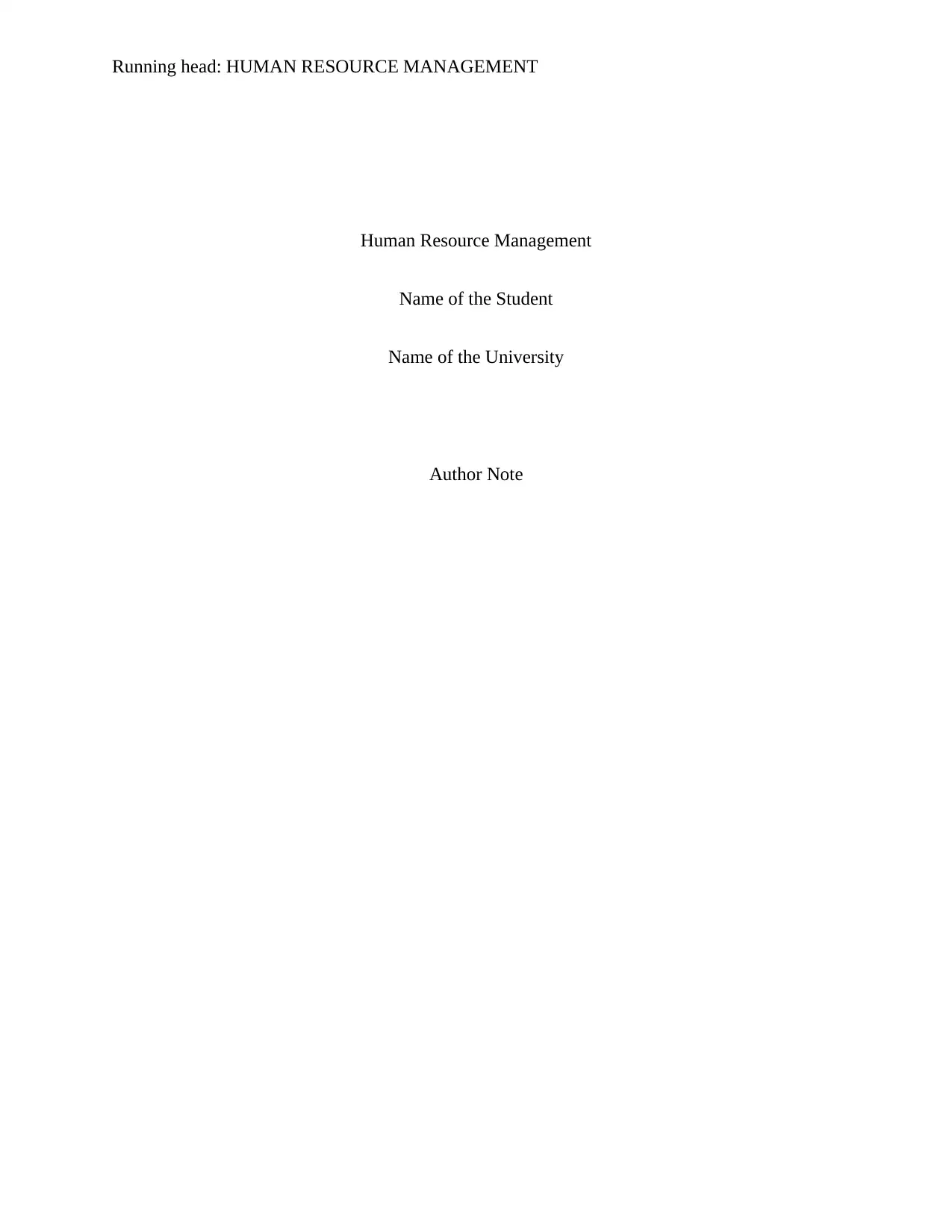
Running head: HUMAN RESOURCE MANAGEMENT
Human Resource Management
Name of the Student
Name of the University
Author Note
Human Resource Management
Name of the Student
Name of the University
Author Note
Secure Best Marks with AI Grader
Need help grading? Try our AI Grader for instant feedback on your assignments.
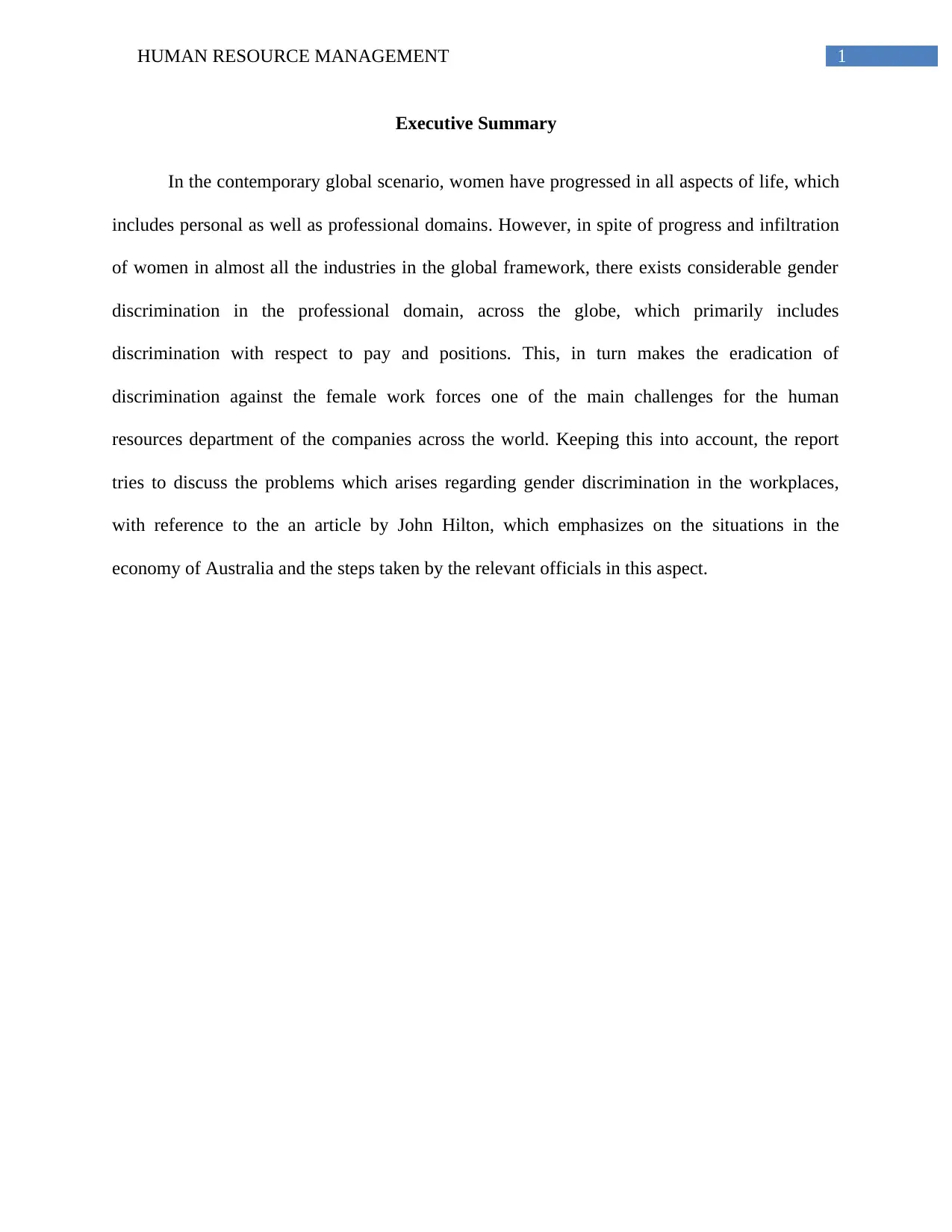
1HUMAN RESOURCE MANAGEMENT
Executive Summary
In the contemporary global scenario, women have progressed in all aspects of life, which
includes personal as well as professional domains. However, in spite of progress and infiltration
of women in almost all the industries in the global framework, there exists considerable gender
discrimination in the professional domain, across the globe, which primarily includes
discrimination with respect to pay and positions. This, in turn makes the eradication of
discrimination against the female work forces one of the main challenges for the human
resources department of the companies across the world. Keeping this into account, the report
tries to discuss the problems which arises regarding gender discrimination in the workplaces,
with reference to the an article by John Hilton, which emphasizes on the situations in the
economy of Australia and the steps taken by the relevant officials in this aspect.
Executive Summary
In the contemporary global scenario, women have progressed in all aspects of life, which
includes personal as well as professional domains. However, in spite of progress and infiltration
of women in almost all the industries in the global framework, there exists considerable gender
discrimination in the professional domain, across the globe, which primarily includes
discrimination with respect to pay and positions. This, in turn makes the eradication of
discrimination against the female work forces one of the main challenges for the human
resources department of the companies across the world. Keeping this into account, the report
tries to discuss the problems which arises regarding gender discrimination in the workplaces,
with reference to the an article by John Hilton, which emphasizes on the situations in the
economy of Australia and the steps taken by the relevant officials in this aspect.
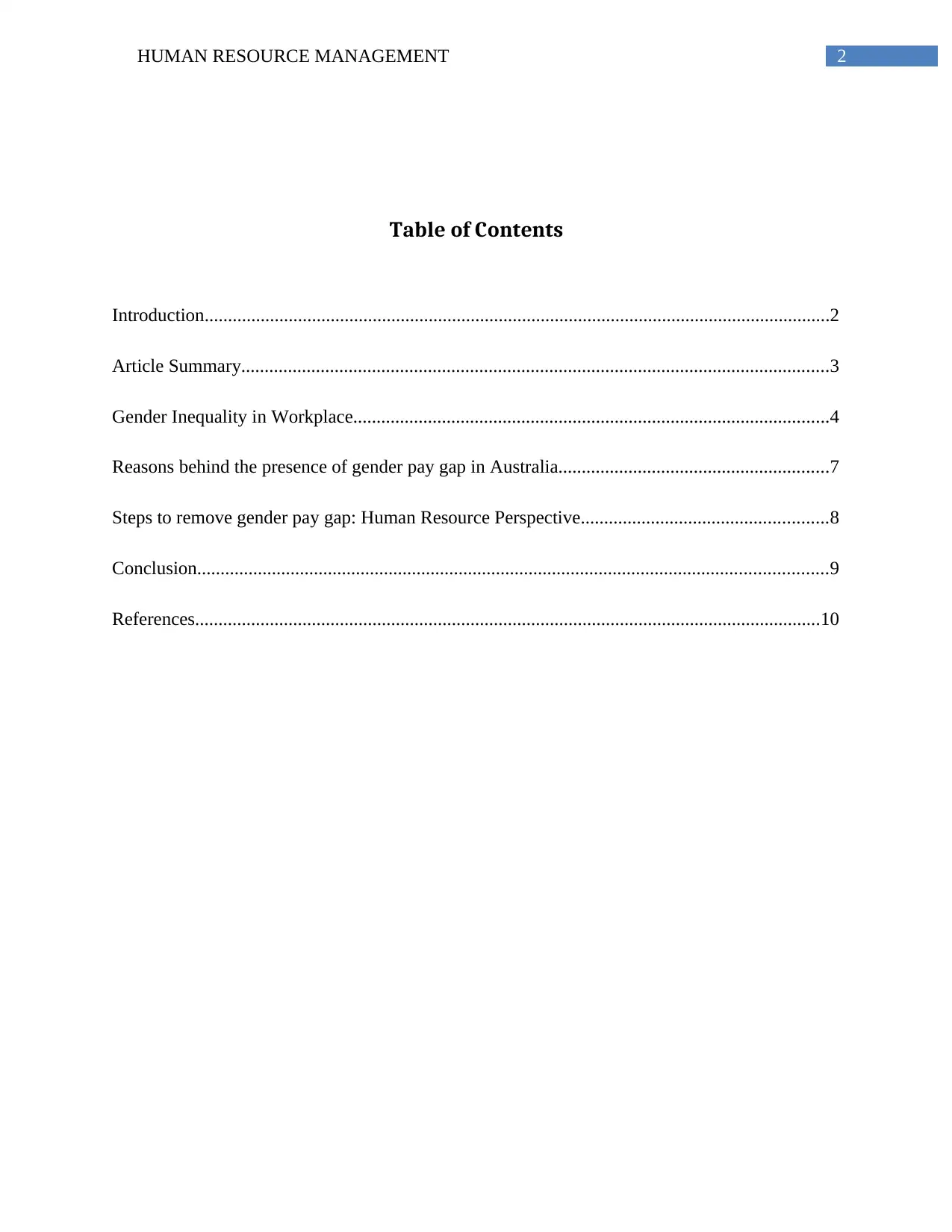
2HUMAN RESOURCE MANAGEMENT
Table of Contents
Introduction......................................................................................................................................2
Article Summary..............................................................................................................................3
Gender Inequality in Workplace......................................................................................................4
Reasons behind the presence of gender pay gap in Australia..........................................................7
Steps to remove gender pay gap: Human Resource Perspective.....................................................8
Conclusion.......................................................................................................................................9
References......................................................................................................................................10
Table of Contents
Introduction......................................................................................................................................2
Article Summary..............................................................................................................................3
Gender Inequality in Workplace......................................................................................................4
Reasons behind the presence of gender pay gap in Australia..........................................................7
Steps to remove gender pay gap: Human Resource Perspective.....................................................8
Conclusion.......................................................................................................................................9
References......................................................................................................................................10
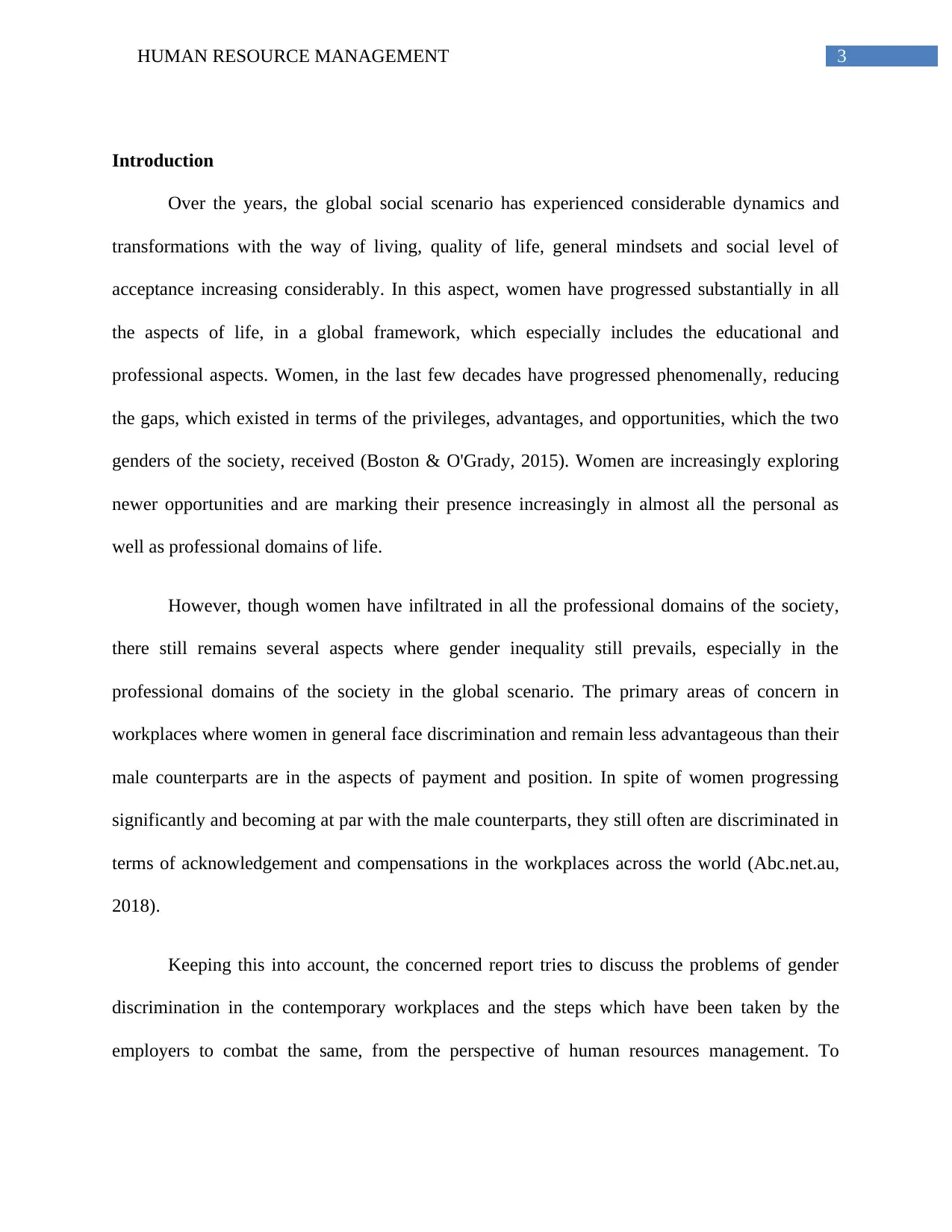
3HUMAN RESOURCE MANAGEMENT
Introduction
Over the years, the global social scenario has experienced considerable dynamics and
transformations with the way of living, quality of life, general mindsets and social level of
acceptance increasing considerably. In this aspect, women have progressed substantially in all
the aspects of life, in a global framework, which especially includes the educational and
professional aspects. Women, in the last few decades have progressed phenomenally, reducing
the gaps, which existed in terms of the privileges, advantages, and opportunities, which the two
genders of the society, received (Boston & O'Grady, 2015). Women are increasingly exploring
newer opportunities and are marking their presence increasingly in almost all the personal as
well as professional domains of life.
However, though women have infiltrated in all the professional domains of the society,
there still remains several aspects where gender inequality still prevails, especially in the
professional domains of the society in the global scenario. The primary areas of concern in
workplaces where women in general face discrimination and remain less advantageous than their
male counterparts are in the aspects of payment and position. In spite of women progressing
significantly and becoming at par with the male counterparts, they still often are discriminated in
terms of acknowledgement and compensations in the workplaces across the world (Abc.net.au,
2018).
Keeping this into account, the concerned report tries to discuss the problems of gender
discrimination in the contemporary workplaces and the steps which have been taken by the
employers to combat the same, from the perspective of human resources management. To
Introduction
Over the years, the global social scenario has experienced considerable dynamics and
transformations with the way of living, quality of life, general mindsets and social level of
acceptance increasing considerably. In this aspect, women have progressed substantially in all
the aspects of life, in a global framework, which especially includes the educational and
professional aspects. Women, in the last few decades have progressed phenomenally, reducing
the gaps, which existed in terms of the privileges, advantages, and opportunities, which the two
genders of the society, received (Boston & O'Grady, 2015). Women are increasingly exploring
newer opportunities and are marking their presence increasingly in almost all the personal as
well as professional domains of life.
However, though women have infiltrated in all the professional domains of the society,
there still remains several aspects where gender inequality still prevails, especially in the
professional domains of the society in the global scenario. The primary areas of concern in
workplaces where women in general face discrimination and remain less advantageous than their
male counterparts are in the aspects of payment and position. In spite of women progressing
significantly and becoming at par with the male counterparts, they still often are discriminated in
terms of acknowledgement and compensations in the workplaces across the world (Abc.net.au,
2018).
Keeping this into account, the concerned report tries to discuss the problems of gender
discrimination in the contemporary workplaces and the steps which have been taken by the
employers to combat the same, from the perspective of human resources management. To
Secure Best Marks with AI Grader
Need help grading? Try our AI Grader for instant feedback on your assignments.
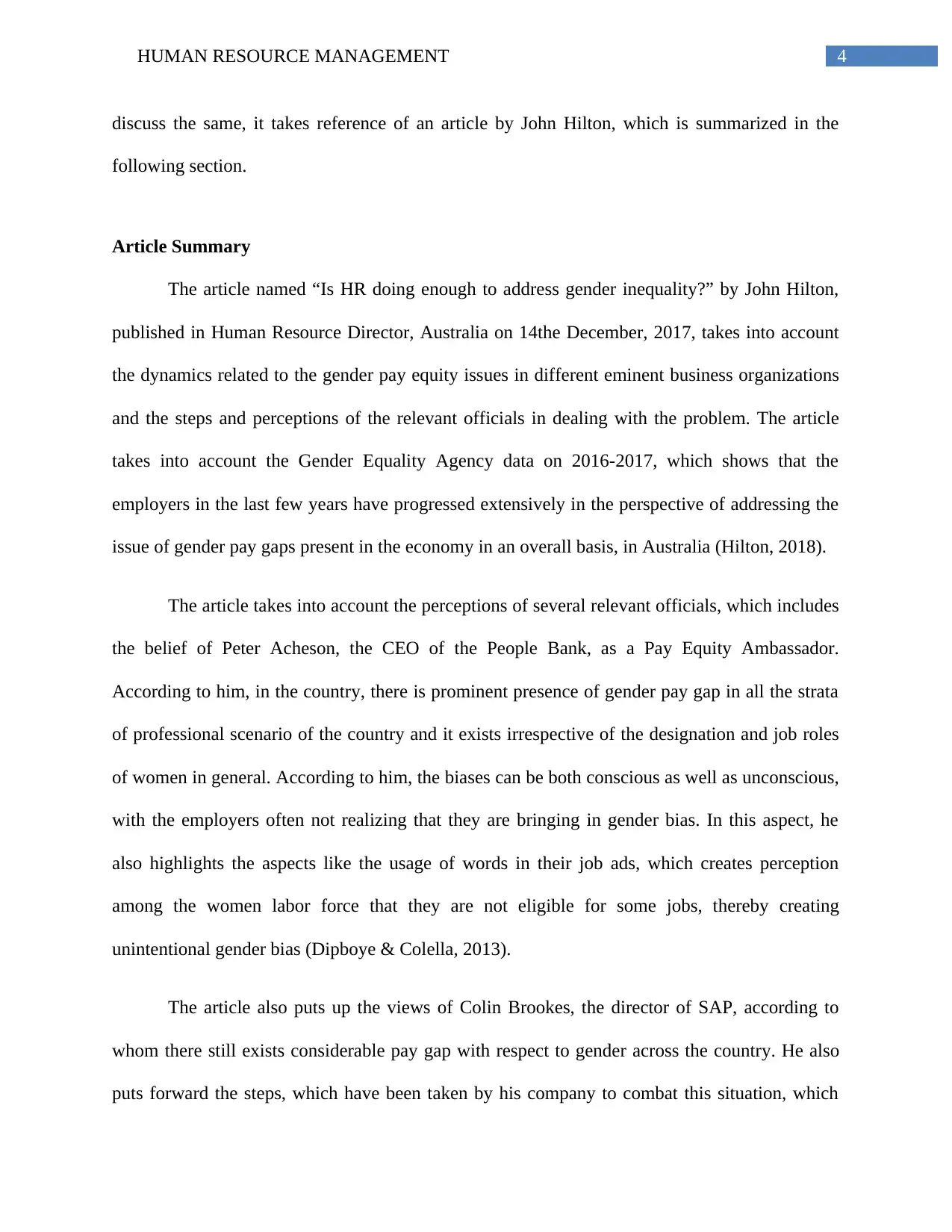
4HUMAN RESOURCE MANAGEMENT
discuss the same, it takes reference of an article by John Hilton, which is summarized in the
following section.
Article Summary
The article named “Is HR doing enough to address gender inequality?” by John Hilton,
published in Human Resource Director, Australia on 14the December, 2017, takes into account
the dynamics related to the gender pay equity issues in different eminent business organizations
and the steps and perceptions of the relevant officials in dealing with the problem. The article
takes into account the Gender Equality Agency data on 2016-2017, which shows that the
employers in the last few years have progressed extensively in the perspective of addressing the
issue of gender pay gaps present in the economy in an overall basis, in Australia (Hilton, 2018).
The article takes into account the perceptions of several relevant officials, which includes
the belief of Peter Acheson, the CEO of the People Bank, as a Pay Equity Ambassador.
According to him, in the country, there is prominent presence of gender pay gap in all the strata
of professional scenario of the country and it exists irrespective of the designation and job roles
of women in general. According to him, the biases can be both conscious as well as unconscious,
with the employers often not realizing that they are bringing in gender bias. In this aspect, he
also highlights the aspects like the usage of words in their job ads, which creates perception
among the women labor force that they are not eligible for some jobs, thereby creating
unintentional gender bias (Dipboye & Colella, 2013).
The article also puts up the views of Colin Brookes, the director of SAP, according to
whom there still exists considerable pay gap with respect to gender across the country. He also
puts forward the steps, which have been taken by his company to combat this situation, which
discuss the same, it takes reference of an article by John Hilton, which is summarized in the
following section.
Article Summary
The article named “Is HR doing enough to address gender inequality?” by John Hilton,
published in Human Resource Director, Australia on 14the December, 2017, takes into account
the dynamics related to the gender pay equity issues in different eminent business organizations
and the steps and perceptions of the relevant officials in dealing with the problem. The article
takes into account the Gender Equality Agency data on 2016-2017, which shows that the
employers in the last few years have progressed extensively in the perspective of addressing the
issue of gender pay gaps present in the economy in an overall basis, in Australia (Hilton, 2018).
The article takes into account the perceptions of several relevant officials, which includes
the belief of Peter Acheson, the CEO of the People Bank, as a Pay Equity Ambassador.
According to him, in the country, there is prominent presence of gender pay gap in all the strata
of professional scenario of the country and it exists irrespective of the designation and job roles
of women in general. According to him, the biases can be both conscious as well as unconscious,
with the employers often not realizing that they are bringing in gender bias. In this aspect, he
also highlights the aspects like the usage of words in their job ads, which creates perception
among the women labor force that they are not eligible for some jobs, thereby creating
unintentional gender bias (Dipboye & Colella, 2013).
The article also puts up the views of Colin Brookes, the director of SAP, according to
whom there still exists considerable pay gap with respect to gender across the country. He also
puts forward the steps, which have been taken by his company to combat this situation, which
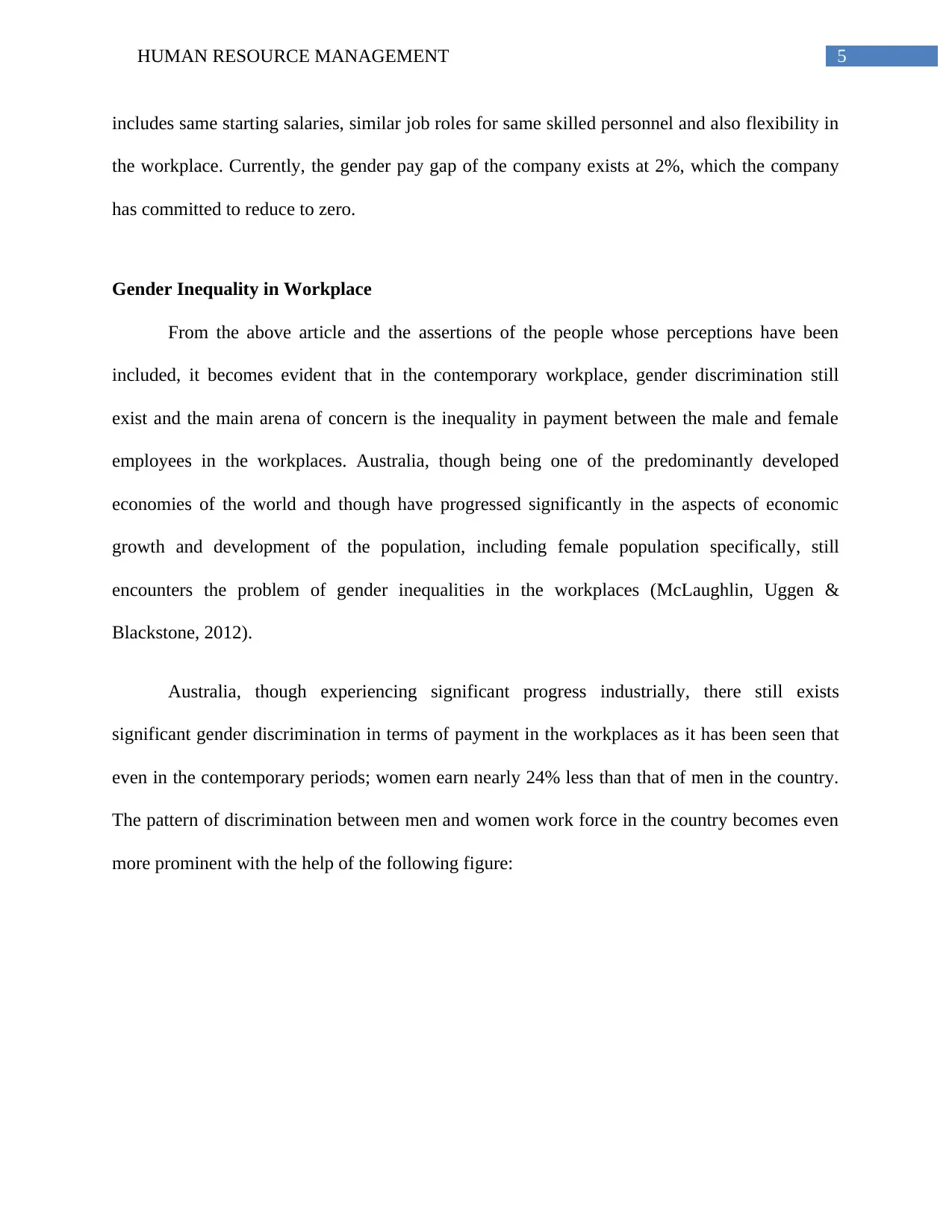
5HUMAN RESOURCE MANAGEMENT
includes same starting salaries, similar job roles for same skilled personnel and also flexibility in
the workplace. Currently, the gender pay gap of the company exists at 2%, which the company
has committed to reduce to zero.
Gender Inequality in Workplace
From the above article and the assertions of the people whose perceptions have been
included, it becomes evident that in the contemporary workplace, gender discrimination still
exist and the main arena of concern is the inequality in payment between the male and female
employees in the workplaces. Australia, though being one of the predominantly developed
economies of the world and though have progressed significantly in the aspects of economic
growth and development of the population, including female population specifically, still
encounters the problem of gender inequalities in the workplaces (McLaughlin, Uggen &
Blackstone, 2012).
Australia, though experiencing significant progress industrially, there still exists
significant gender discrimination in terms of payment in the workplaces as it has been seen that
even in the contemporary periods; women earn nearly 24% less than that of men in the country.
The pattern of discrimination between men and women work force in the country becomes even
more prominent with the help of the following figure:
includes same starting salaries, similar job roles for same skilled personnel and also flexibility in
the workplace. Currently, the gender pay gap of the company exists at 2%, which the company
has committed to reduce to zero.
Gender Inequality in Workplace
From the above article and the assertions of the people whose perceptions have been
included, it becomes evident that in the contemporary workplace, gender discrimination still
exist and the main arena of concern is the inequality in payment between the male and female
employees in the workplaces. Australia, though being one of the predominantly developed
economies of the world and though have progressed significantly in the aspects of economic
growth and development of the population, including female population specifically, still
encounters the problem of gender inequalities in the workplaces (McLaughlin, Uggen &
Blackstone, 2012).
Australia, though experiencing significant progress industrially, there still exists
significant gender discrimination in terms of payment in the workplaces as it has been seen that
even in the contemporary periods; women earn nearly 24% less than that of men in the country.
The pattern of discrimination between men and women work force in the country becomes even
more prominent with the help of the following figure:
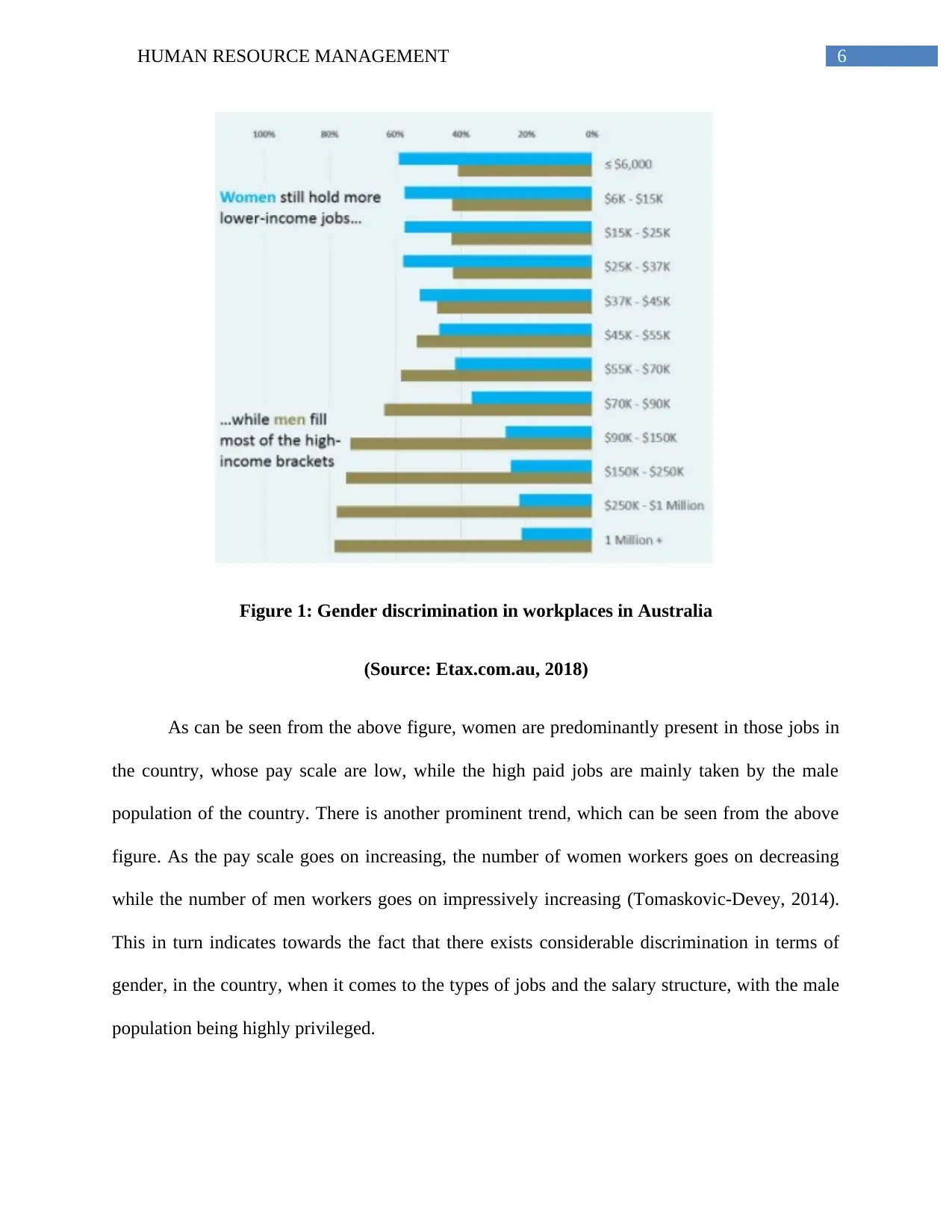
6HUMAN RESOURCE MANAGEMENT
Figure 1: Gender discrimination in workplaces in Australia
(Source: Etax.com.au, 2018)
As can be seen from the above figure, women are predominantly present in those jobs in
the country, whose pay scale are low, while the high paid jobs are mainly taken by the male
population of the country. There is another prominent trend, which can be seen from the above
figure. As the pay scale goes on increasing, the number of women workers goes on decreasing
while the number of men workers goes on impressively increasing (Tomaskovic-Devey, 2014).
This in turn indicates towards the fact that there exists considerable discrimination in terms of
gender, in the country, when it comes to the types of jobs and the salary structure, with the male
population being highly privileged.
Figure 1: Gender discrimination in workplaces in Australia
(Source: Etax.com.au, 2018)
As can be seen from the above figure, women are predominantly present in those jobs in
the country, whose pay scale are low, while the high paid jobs are mainly taken by the male
population of the country. There is another prominent trend, which can be seen from the above
figure. As the pay scale goes on increasing, the number of women workers goes on decreasing
while the number of men workers goes on impressively increasing (Tomaskovic-Devey, 2014).
This in turn indicates towards the fact that there exists considerable discrimination in terms of
gender, in the country, when it comes to the types of jobs and the salary structure, with the male
population being highly privileged.
Paraphrase This Document
Need a fresh take? Get an instant paraphrase of this document with our AI Paraphraser
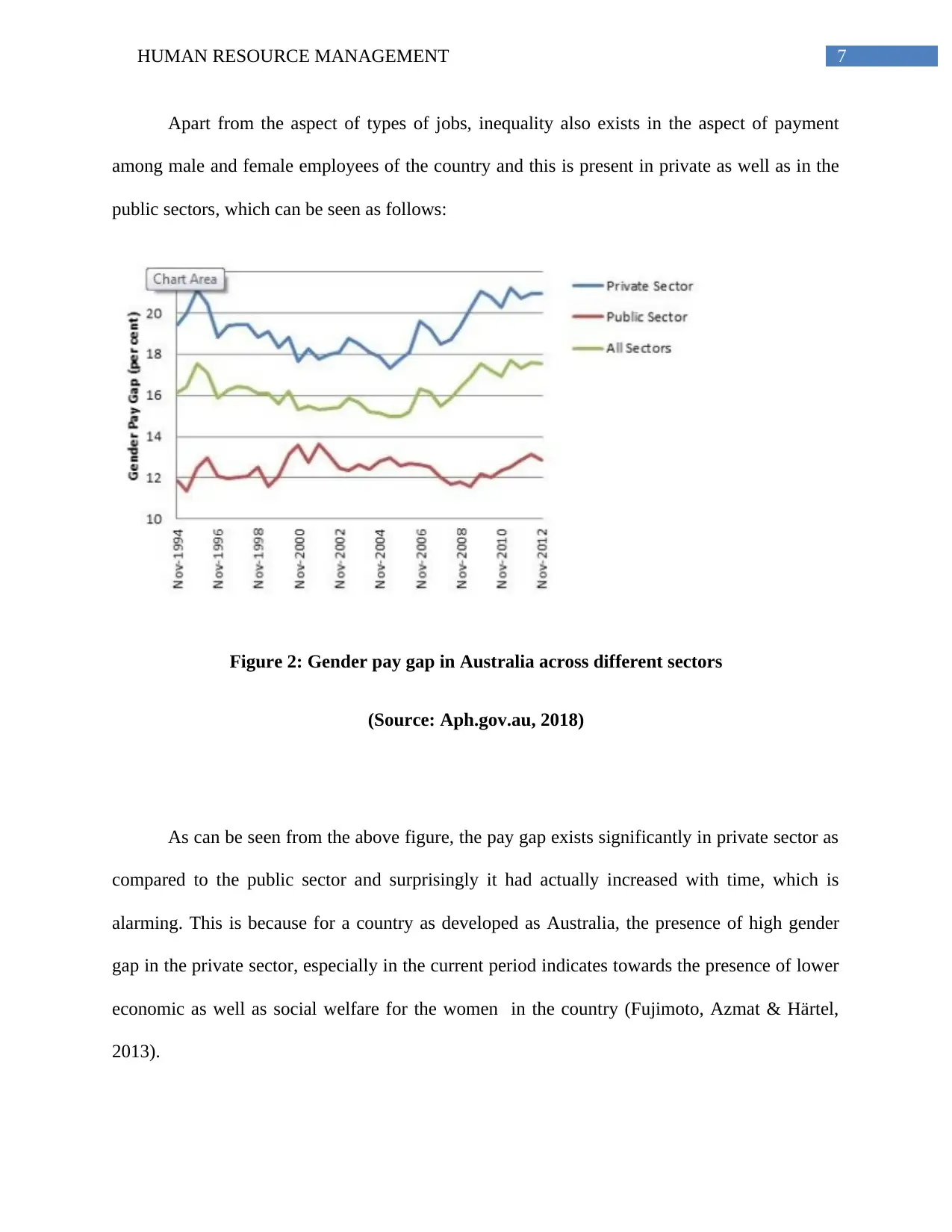
7HUMAN RESOURCE MANAGEMENT
Apart from the aspect of types of jobs, inequality also exists in the aspect of payment
among male and female employees of the country and this is present in private as well as in the
public sectors, which can be seen as follows:
Figure 2: Gender pay gap in Australia across different sectors
(Source: Aph.gov.au, 2018)
As can be seen from the above figure, the pay gap exists significantly in private sector as
compared to the public sector and surprisingly it had actually increased with time, which is
alarming. This is because for a country as developed as Australia, the presence of high gender
gap in the private sector, especially in the current period indicates towards the presence of lower
economic as well as social welfare for the women in the country (Fujimoto, Azmat & Härtel,
2013).
Apart from the aspect of types of jobs, inequality also exists in the aspect of payment
among male and female employees of the country and this is present in private as well as in the
public sectors, which can be seen as follows:
Figure 2: Gender pay gap in Australia across different sectors
(Source: Aph.gov.au, 2018)
As can be seen from the above figure, the pay gap exists significantly in private sector as
compared to the public sector and surprisingly it had actually increased with time, which is
alarming. This is because for a country as developed as Australia, the presence of high gender
gap in the private sector, especially in the current period indicates towards the presence of lower
economic as well as social welfare for the women in the country (Fujimoto, Azmat & Härtel,
2013).
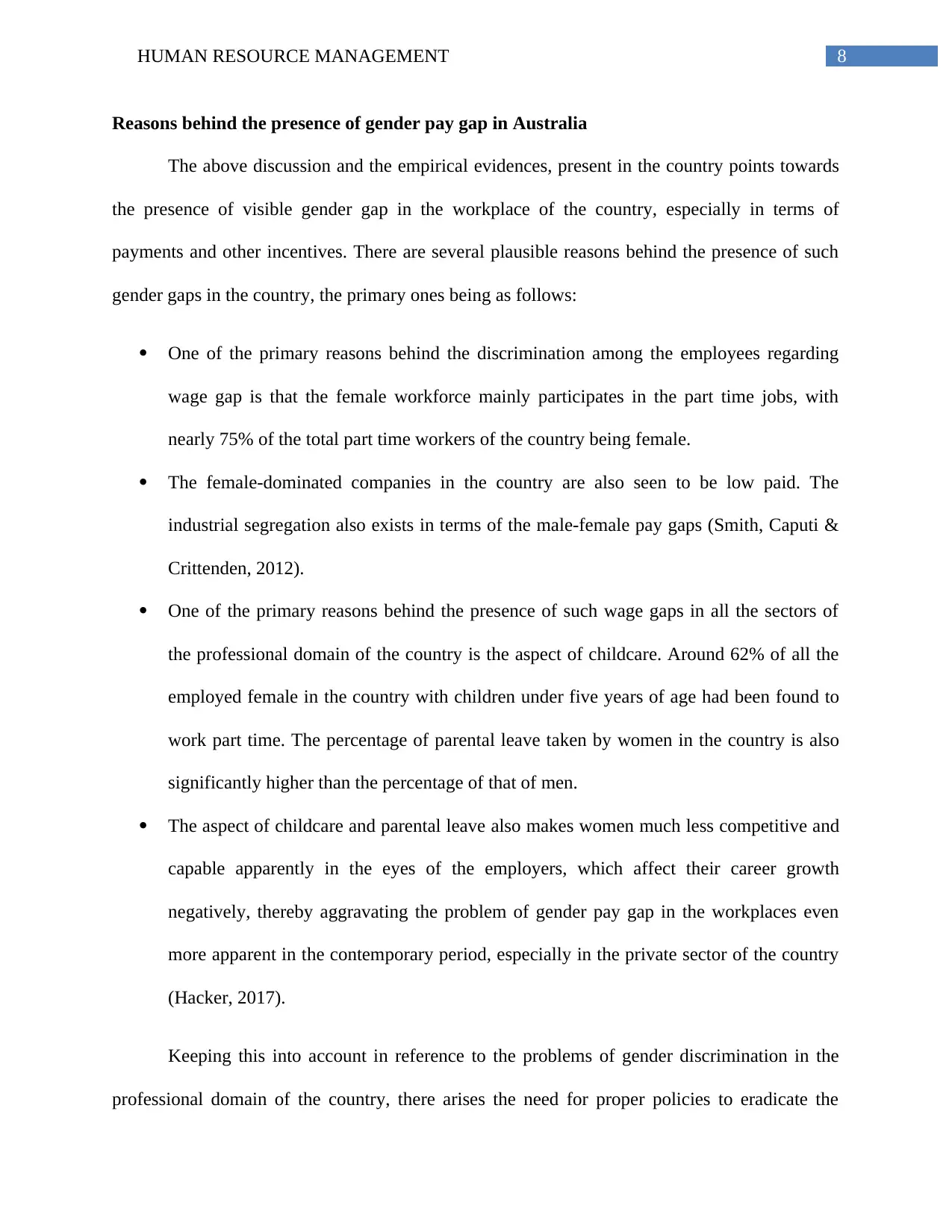
8HUMAN RESOURCE MANAGEMENT
Reasons behind the presence of gender pay gap in Australia
The above discussion and the empirical evidences, present in the country points towards
the presence of visible gender gap in the workplace of the country, especially in terms of
payments and other incentives. There are several plausible reasons behind the presence of such
gender gaps in the country, the primary ones being as follows:
One of the primary reasons behind the discrimination among the employees regarding
wage gap is that the female workforce mainly participates in the part time jobs, with
nearly 75% of the total part time workers of the country being female.
The female-dominated companies in the country are also seen to be low paid. The
industrial segregation also exists in terms of the male-female pay gaps (Smith, Caputi &
Crittenden, 2012).
One of the primary reasons behind the presence of such wage gaps in all the sectors of
the professional domain of the country is the aspect of childcare. Around 62% of all the
employed female in the country with children under five years of age had been found to
work part time. The percentage of parental leave taken by women in the country is also
significantly higher than the percentage of that of men.
The aspect of childcare and parental leave also makes women much less competitive and
capable apparently in the eyes of the employers, which affect their career growth
negatively, thereby aggravating the problem of gender pay gap in the workplaces even
more apparent in the contemporary period, especially in the private sector of the country
(Hacker, 2017).
Keeping this into account in reference to the problems of gender discrimination in the
professional domain of the country, there arises the need for proper policies to eradicate the
Reasons behind the presence of gender pay gap in Australia
The above discussion and the empirical evidences, present in the country points towards
the presence of visible gender gap in the workplace of the country, especially in terms of
payments and other incentives. There are several plausible reasons behind the presence of such
gender gaps in the country, the primary ones being as follows:
One of the primary reasons behind the discrimination among the employees regarding
wage gap is that the female workforce mainly participates in the part time jobs, with
nearly 75% of the total part time workers of the country being female.
The female-dominated companies in the country are also seen to be low paid. The
industrial segregation also exists in terms of the male-female pay gaps (Smith, Caputi &
Crittenden, 2012).
One of the primary reasons behind the presence of such wage gaps in all the sectors of
the professional domain of the country is the aspect of childcare. Around 62% of all the
employed female in the country with children under five years of age had been found to
work part time. The percentage of parental leave taken by women in the country is also
significantly higher than the percentage of that of men.
The aspect of childcare and parental leave also makes women much less competitive and
capable apparently in the eyes of the employers, which affect their career growth
negatively, thereby aggravating the problem of gender pay gap in the workplaces even
more apparent in the contemporary period, especially in the private sector of the country
(Hacker, 2017).
Keeping this into account in reference to the problems of gender discrimination in the
professional domain of the country, there arises the need for proper policies to eradicate the
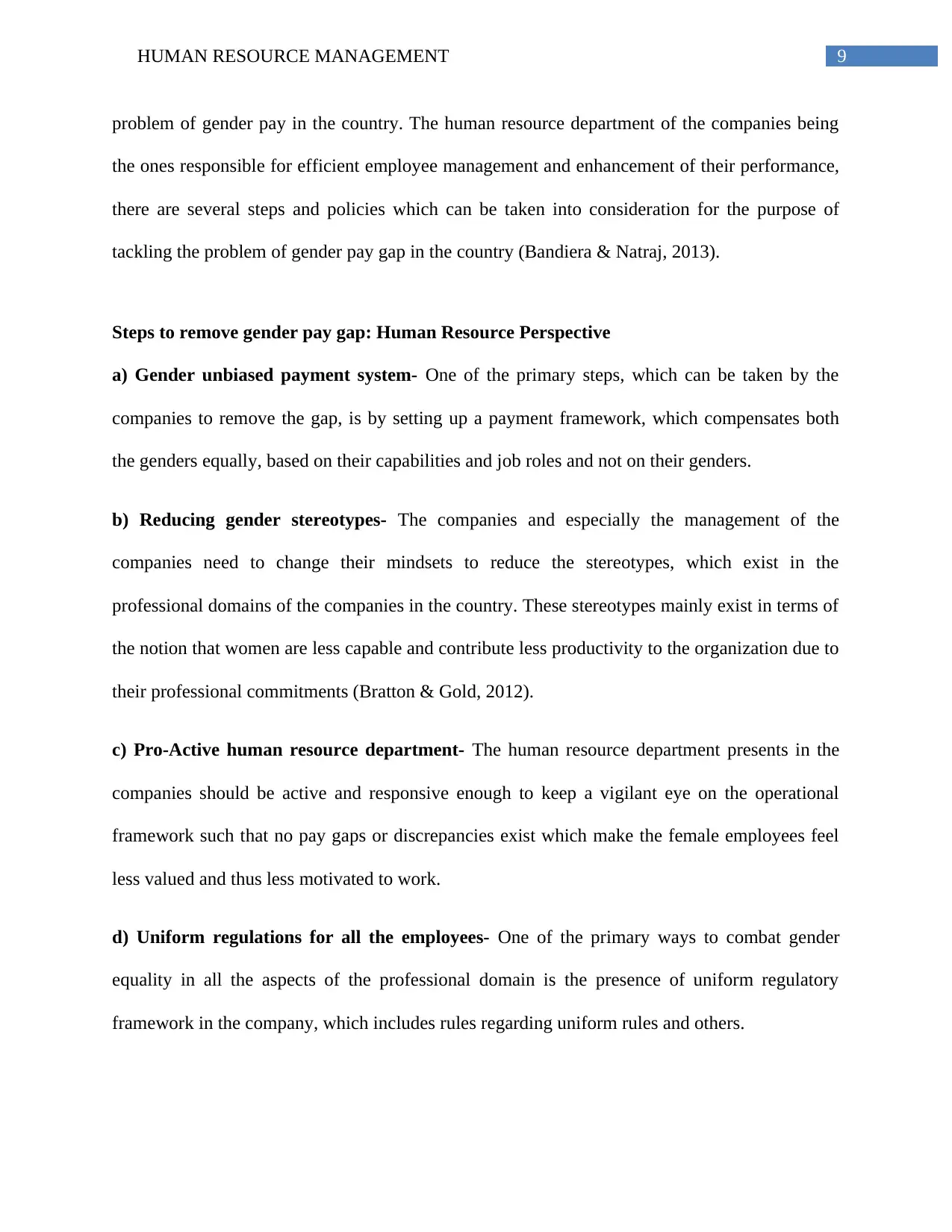
9HUMAN RESOURCE MANAGEMENT
problem of gender pay in the country. The human resource department of the companies being
the ones responsible for efficient employee management and enhancement of their performance,
there are several steps and policies which can be taken into consideration for the purpose of
tackling the problem of gender pay gap in the country (Bandiera & Natraj, 2013).
Steps to remove gender pay gap: Human Resource Perspective
a) Gender unbiased payment system- One of the primary steps, which can be taken by the
companies to remove the gap, is by setting up a payment framework, which compensates both
the genders equally, based on their capabilities and job roles and not on their genders.
b) Reducing gender stereotypes- The companies and especially the management of the
companies need to change their mindsets to reduce the stereotypes, which exist in the
professional domains of the companies in the country. These stereotypes mainly exist in terms of
the notion that women are less capable and contribute less productivity to the organization due to
their professional commitments (Bratton & Gold, 2012).
c) Pro-Active human resource department- The human resource department presents in the
companies should be active and responsive enough to keep a vigilant eye on the operational
framework such that no pay gaps or discrepancies exist which make the female employees feel
less valued and thus less motivated to work.
d) Uniform regulations for all the employees- One of the primary ways to combat gender
equality in all the aspects of the professional domain is the presence of uniform regulatory
framework in the company, which includes rules regarding uniform rules and others.
problem of gender pay in the country. The human resource department of the companies being
the ones responsible for efficient employee management and enhancement of their performance,
there are several steps and policies which can be taken into consideration for the purpose of
tackling the problem of gender pay gap in the country (Bandiera & Natraj, 2013).
Steps to remove gender pay gap: Human Resource Perspective
a) Gender unbiased payment system- One of the primary steps, which can be taken by the
companies to remove the gap, is by setting up a payment framework, which compensates both
the genders equally, based on their capabilities and job roles and not on their genders.
b) Reducing gender stereotypes- The companies and especially the management of the
companies need to change their mindsets to reduce the stereotypes, which exist in the
professional domains of the companies in the country. These stereotypes mainly exist in terms of
the notion that women are less capable and contribute less productivity to the organization due to
their professional commitments (Bratton & Gold, 2012).
c) Pro-Active human resource department- The human resource department presents in the
companies should be active and responsive enough to keep a vigilant eye on the operational
framework such that no pay gaps or discrepancies exist which make the female employees feel
less valued and thus less motivated to work.
d) Uniform regulations for all the employees- One of the primary ways to combat gender
equality in all the aspects of the professional domain is the presence of uniform regulatory
framework in the company, which includes rules regarding uniform rules and others.
Secure Best Marks with AI Grader
Need help grading? Try our AI Grader for instant feedback on your assignments.
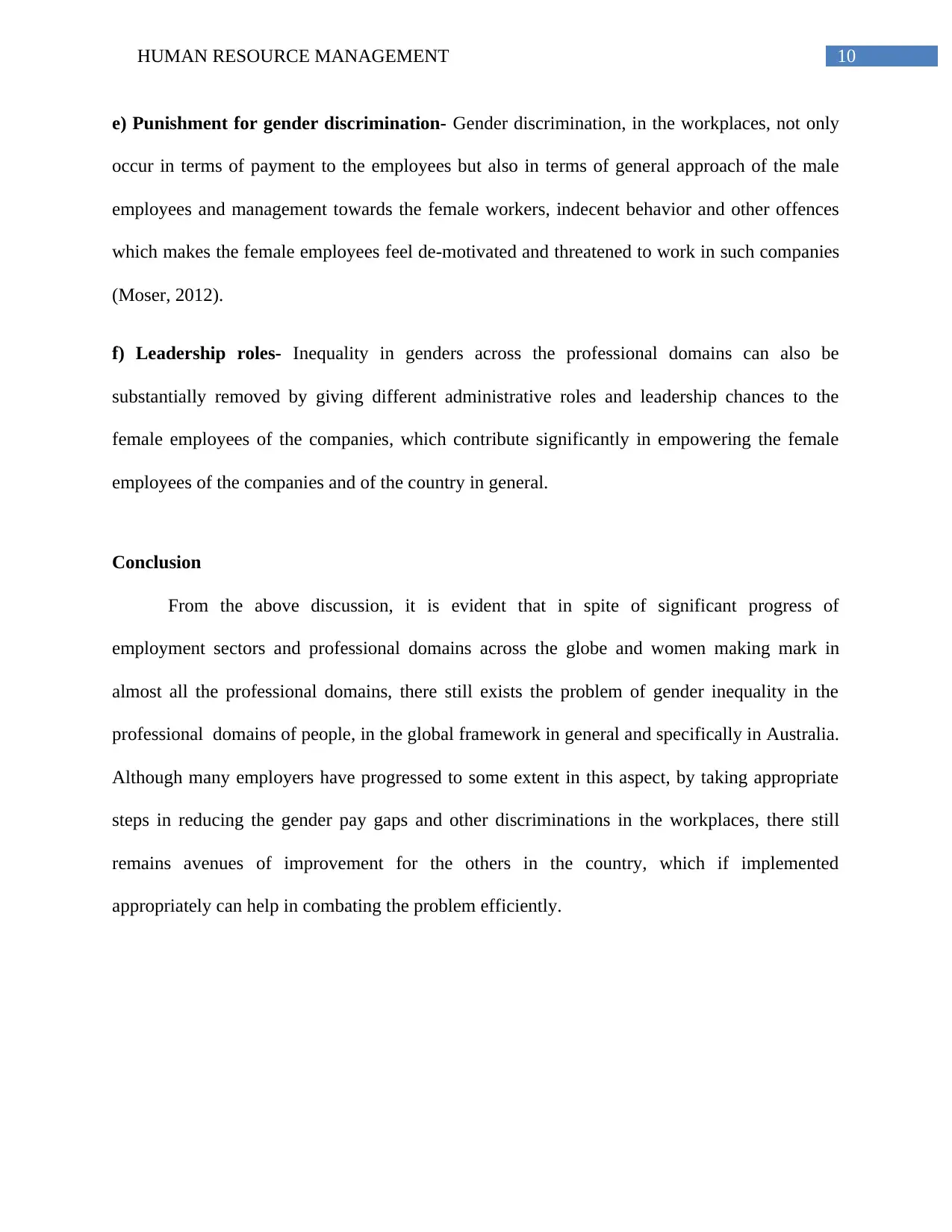
10HUMAN RESOURCE MANAGEMENT
e) Punishment for gender discrimination- Gender discrimination, in the workplaces, not only
occur in terms of payment to the employees but also in terms of general approach of the male
employees and management towards the female workers, indecent behavior and other offences
which makes the female employees feel de-motivated and threatened to work in such companies
(Moser, 2012).
f) Leadership roles- Inequality in genders across the professional domains can also be
substantially removed by giving different administrative roles and leadership chances to the
female employees of the companies, which contribute significantly in empowering the female
employees of the companies and of the country in general.
Conclusion
From the above discussion, it is evident that in spite of significant progress of
employment sectors and professional domains across the globe and women making mark in
almost all the professional domains, there still exists the problem of gender inequality in the
professional domains of people, in the global framework in general and specifically in Australia.
Although many employers have progressed to some extent in this aspect, by taking appropriate
steps in reducing the gender pay gaps and other discriminations in the workplaces, there still
remains avenues of improvement for the others in the country, which if implemented
appropriately can help in combating the problem efficiently.
e) Punishment for gender discrimination- Gender discrimination, in the workplaces, not only
occur in terms of payment to the employees but also in terms of general approach of the male
employees and management towards the female workers, indecent behavior and other offences
which makes the female employees feel de-motivated and threatened to work in such companies
(Moser, 2012).
f) Leadership roles- Inequality in genders across the professional domains can also be
substantially removed by giving different administrative roles and leadership chances to the
female employees of the companies, which contribute significantly in empowering the female
employees of the companies and of the country in general.
Conclusion
From the above discussion, it is evident that in spite of significant progress of
employment sectors and professional domains across the globe and women making mark in
almost all the professional domains, there still exists the problem of gender inequality in the
professional domains of people, in the global framework in general and specifically in Australia.
Although many employers have progressed to some extent in this aspect, by taking appropriate
steps in reducing the gender pay gaps and other discriminations in the workplaces, there still
remains avenues of improvement for the others in the country, which if implemented
appropriately can help in combating the problem efficiently.
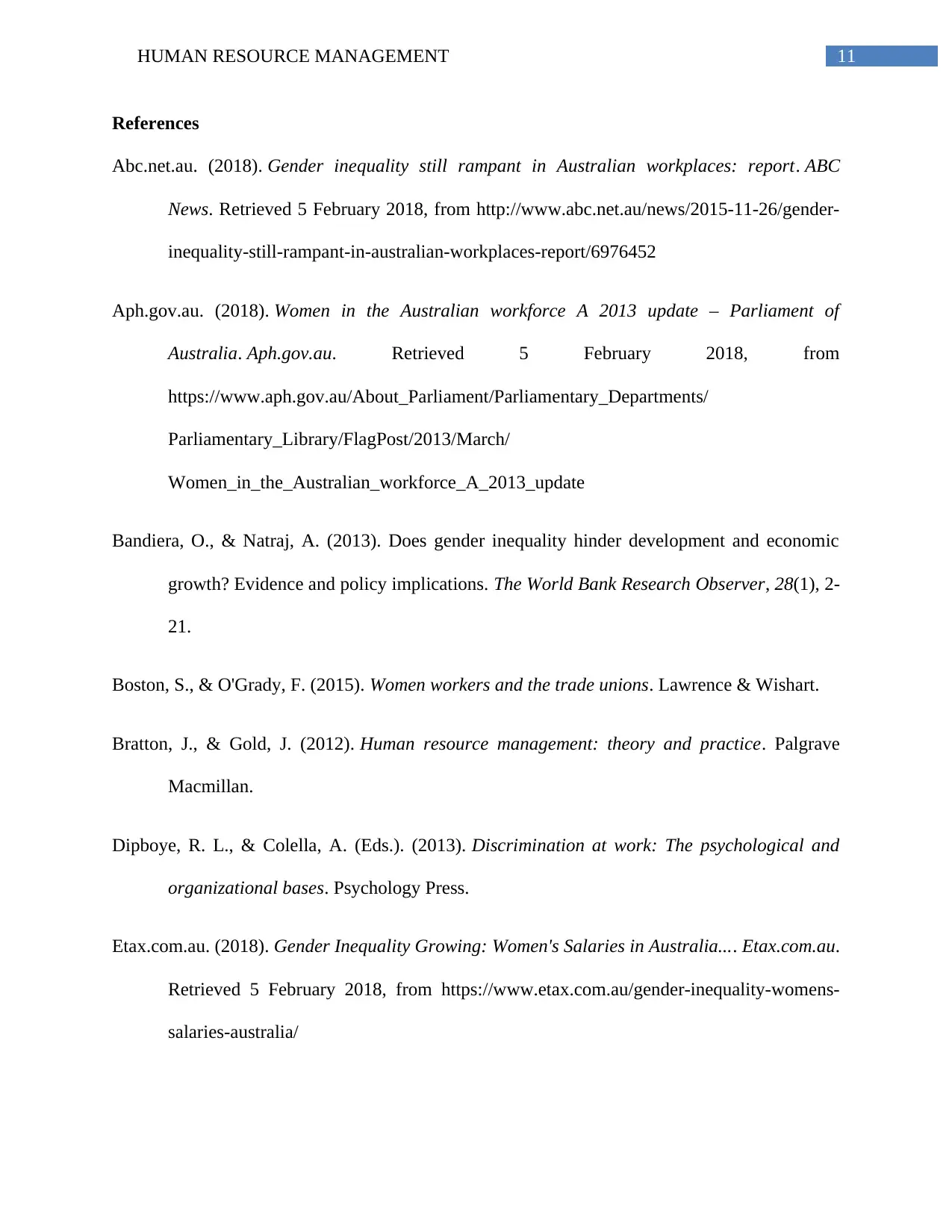
11HUMAN RESOURCE MANAGEMENT
References
Abc.net.au. (2018). Gender inequality still rampant in Australian workplaces: report. ABC
News. Retrieved 5 February 2018, from http://www.abc.net.au/news/2015-11-26/gender-
inequality-still-rampant-in-australian-workplaces-report/6976452
Aph.gov.au. (2018). Women in the Australian workforce A 2013 update – Parliament of
Australia. Aph.gov.au. Retrieved 5 February 2018, from
https://www.aph.gov.au/About_Parliament/Parliamentary_Departments/
Parliamentary_Library/FlagPost/2013/March/
Women_in_the_Australian_workforce_A_2013_update
Bandiera, O., & Natraj, A. (2013). Does gender inequality hinder development and economic
growth? Evidence and policy implications. The World Bank Research Observer, 28(1), 2-
21.
Boston, S., & O'Grady, F. (2015). Women workers and the trade unions. Lawrence & Wishart.
Bratton, J., & Gold, J. (2012). Human resource management: theory and practice. Palgrave
Macmillan.
Dipboye, R. L., & Colella, A. (Eds.). (2013). Discrimination at work: The psychological and
organizational bases. Psychology Press.
Etax.com.au. (2018). Gender Inequality Growing: Women's Salaries in Australia.... Etax.com.au.
Retrieved 5 February 2018, from https://www.etax.com.au/gender-inequality-womens-
salaries-australia/
References
Abc.net.au. (2018). Gender inequality still rampant in Australian workplaces: report. ABC
News. Retrieved 5 February 2018, from http://www.abc.net.au/news/2015-11-26/gender-
inequality-still-rampant-in-australian-workplaces-report/6976452
Aph.gov.au. (2018). Women in the Australian workforce A 2013 update – Parliament of
Australia. Aph.gov.au. Retrieved 5 February 2018, from
https://www.aph.gov.au/About_Parliament/Parliamentary_Departments/
Parliamentary_Library/FlagPost/2013/March/
Women_in_the_Australian_workforce_A_2013_update
Bandiera, O., & Natraj, A. (2013). Does gender inequality hinder development and economic
growth? Evidence and policy implications. The World Bank Research Observer, 28(1), 2-
21.
Boston, S., & O'Grady, F. (2015). Women workers and the trade unions. Lawrence & Wishart.
Bratton, J., & Gold, J. (2012). Human resource management: theory and practice. Palgrave
Macmillan.
Dipboye, R. L., & Colella, A. (Eds.). (2013). Discrimination at work: The psychological and
organizational bases. Psychology Press.
Etax.com.au. (2018). Gender Inequality Growing: Women's Salaries in Australia.... Etax.com.au.
Retrieved 5 February 2018, from https://www.etax.com.au/gender-inequality-womens-
salaries-australia/
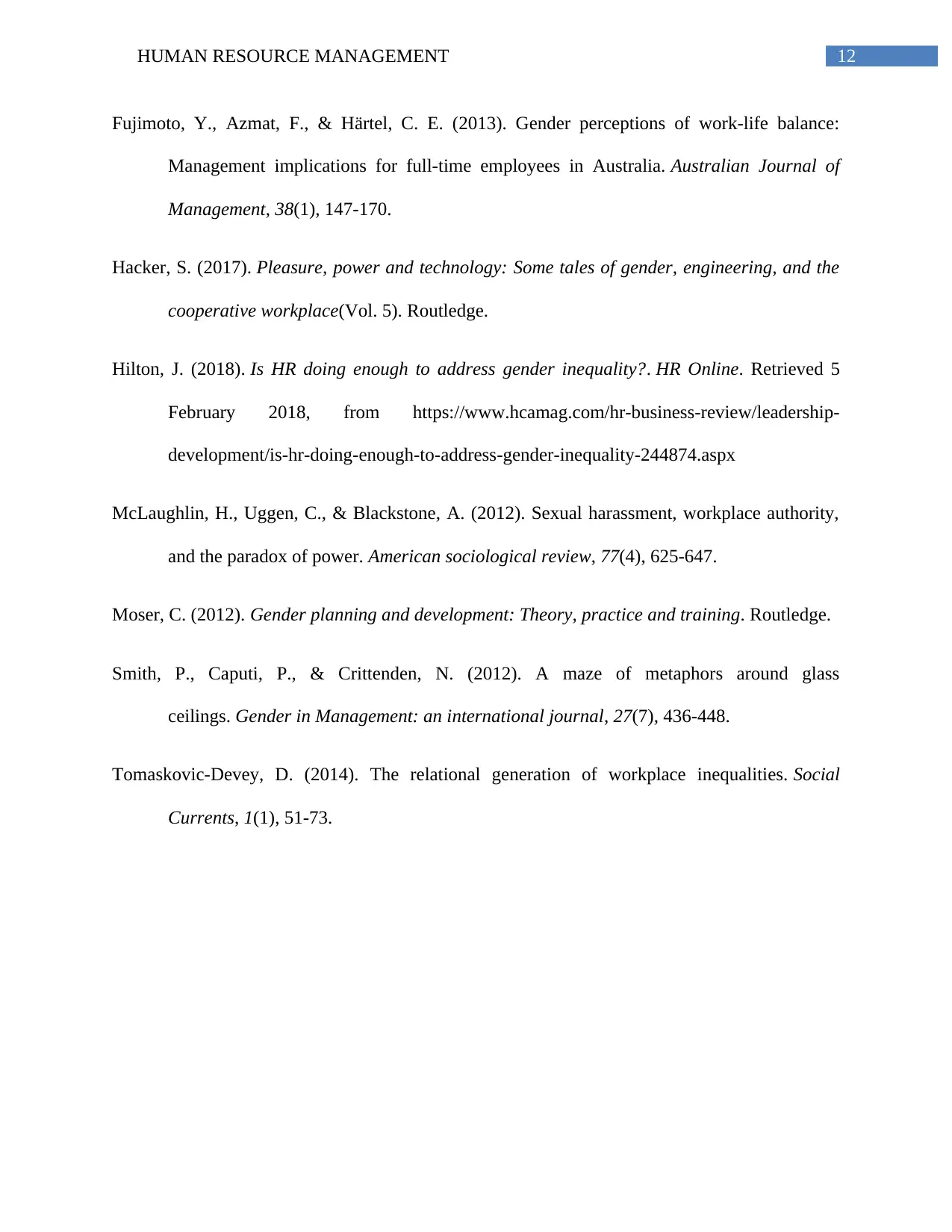
12HUMAN RESOURCE MANAGEMENT
Fujimoto, Y., Azmat, F., & Härtel, C. E. (2013). Gender perceptions of work-life balance:
Management implications for full-time employees in Australia. Australian Journal of
Management, 38(1), 147-170.
Hacker, S. (2017). Pleasure, power and technology: Some tales of gender, engineering, and the
cooperative workplace(Vol. 5). Routledge.
Hilton, J. (2018). Is HR doing enough to address gender inequality?. HR Online. Retrieved 5
February 2018, from https://www.hcamag.com/hr-business-review/leadership-
development/is-hr-doing-enough-to-address-gender-inequality-244874.aspx
McLaughlin, H., Uggen, C., & Blackstone, A. (2012). Sexual harassment, workplace authority,
and the paradox of power. American sociological review, 77(4), 625-647.
Moser, C. (2012). Gender planning and development: Theory, practice and training. Routledge.
Smith, P., Caputi, P., & Crittenden, N. (2012). A maze of metaphors around glass
ceilings. Gender in Management: an international journal, 27(7), 436-448.
Tomaskovic-Devey, D. (2014). The relational generation of workplace inequalities. Social
Currents, 1(1), 51-73.
Fujimoto, Y., Azmat, F., & Härtel, C. E. (2013). Gender perceptions of work-life balance:
Management implications for full-time employees in Australia. Australian Journal of
Management, 38(1), 147-170.
Hacker, S. (2017). Pleasure, power and technology: Some tales of gender, engineering, and the
cooperative workplace(Vol. 5). Routledge.
Hilton, J. (2018). Is HR doing enough to address gender inequality?. HR Online. Retrieved 5
February 2018, from https://www.hcamag.com/hr-business-review/leadership-
development/is-hr-doing-enough-to-address-gender-inequality-244874.aspx
McLaughlin, H., Uggen, C., & Blackstone, A. (2012). Sexual harassment, workplace authority,
and the paradox of power. American sociological review, 77(4), 625-647.
Moser, C. (2012). Gender planning and development: Theory, practice and training. Routledge.
Smith, P., Caputi, P., & Crittenden, N. (2012). A maze of metaphors around glass
ceilings. Gender in Management: an international journal, 27(7), 436-448.
Tomaskovic-Devey, D. (2014). The relational generation of workplace inequalities. Social
Currents, 1(1), 51-73.
1 out of 13
Your All-in-One AI-Powered Toolkit for Academic Success.
+13062052269
info@desklib.com
Available 24*7 on WhatsApp / Email
![[object Object]](/_next/static/media/star-bottom.7253800d.svg)
Unlock your academic potential
© 2024 | Zucol Services PVT LTD | All rights reserved.





